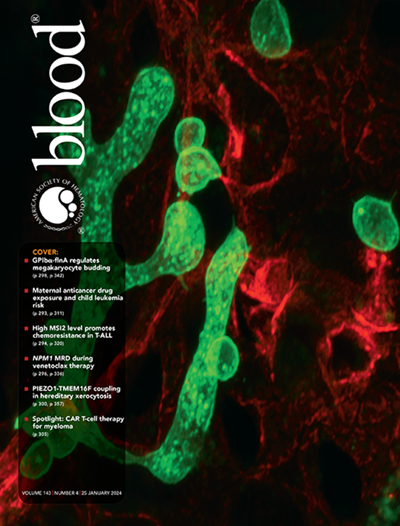突破溶血在阵发性夜间血红蛋白尿贯穿临床试验:从定义到临床实践。
IF 21
1区 医学
Q1 HEMATOLOGY
引用次数: 0
摘要
突破性溶血(BTH)是在接受抗补体治疗的阵发性夜间血红蛋白尿(PNH)患者中发生的溶血恶化。在这篇综述文章中,我们分析了终末(抗C5 ravulizumab和crovalimab)和上游C5补体抑制剂(抗c3 pegcetacoplan,替代途径抑制剂iptacopan和danicopan)的3期临床试验中BTH事件的定义、频率和严重程度,以及现实世界的报告。此外,我们回顾了各种化合物对生活质量和患者报告的结果的影响。特别是,所有补体抑制剂都可能发生BTH,在6个月内,依曲利珠单抗、克罗伐单抗和pegcetacoplan的发生率为10-15%,而拉曲利珠单抗、伊他科潘和达尼可潘加抗- c5的发生率<5%。随着随访时间的延长,与抗c5、伊普他科泮和达尼可潘加抗c5双抑制相比,pegcetacoplan治疗的患者出现BTH的频率增加(1年时接近24%)。BTH风险似乎与患者的特征有关,特别是既往补体抑制剂的次优反应/失败。大约一半的病例需要输血,抗补体治疗的修改包括预期下一个抗c5剂量和在近端抑制剂患者中添加eculizumab。突破血栓是罕见的,虽然抗凝预防应考虑在严重发作。在大约一半的病例中观察到补体扩增条件,并且更频繁地感染。治疗依从性、给药方案的优化、抗凝预防以及患者和医生的教育仍然是预防BTH及其并发症的重要因素。本文章由计算机程序翻译,如有差异,请以英文原文为准。
Breakthrough hemolysis in paroxysmal nocturnal hemoglobinuria throughout clinical trials: from definition to clinical practice.
Breakthrough hemolysis (BTH) is the hemolytic exacerbation occurring in a patient with paroxysmal nocturnal hemoglobinuria (PNH) on treatment with anti-complement therapies. In this review article we analysed the definition, frequency and severity of BTH events across phase 3 clinical trials with terminal (anti-C5 ravulizumab and crovalimab) and complement inhibitors upstream C5 (anti-C3 pegcetacoplan, alternative-pathway inhibitors iptacopan and danicopan), as well as from real-world reports. Furthermore, we reviewed the impact of the various compounds on quality of life and patients reported outcomes. In particular, BTH may occur with all complement inhibitors, with a frequency of 10-15% over 6 months with eculizumab, crovalimab, and pegcetacoplan, and <5% with ravulizumab, iptacopan, and danicopan plus anti-C5. By prolonging the follow-up, the frequency of BTH appeared increased in pegcetacoplan treated patients (nearly 24% at 1 year) as compared to both anti-C5, iptacopan, and double inhibition with danicopan plus anti-C5. BTH risk appears associated with patients' features, particularly suboptimal response/failure of previous complement inhibitor. Transfusions were required in about half of cases and modifications of anti-complement therapy included anticipation of the next anti-C5 dose and addition of eculizumab in patients on proximal inhibitors. Breakthrough thromboses were rare, though anti-coagulant prophylaxis should be considered during severe episodes. Complement amplifying conditions were observed in about half of cases and were more frequently infections. Treatment adherence, optimization of the administration schedule, anticoagulant prophylaxis, as well as education of patients and physicians remain important factors to prevent BTH and its complications.
求助全文
通过发布文献求助,成功后即可免费获取论文全文。
去求助
来源期刊

Blood
医学-血液学
CiteScore
23.60
自引率
3.90%
发文量
955
审稿时长
1 months
期刊介绍:
Blood, the official journal of the American Society of Hematology, published online and in print, provides an international forum for the publication of original articles describing basic laboratory, translational, and clinical investigations in hematology. Primary research articles will be published under the following scientific categories: Clinical Trials and Observations; Gene Therapy; Hematopoiesis and Stem Cells; Immunobiology and Immunotherapy scope; Myeloid Neoplasia; Lymphoid Neoplasia; Phagocytes, Granulocytes and Myelopoiesis; Platelets and Thrombopoiesis; Red Cells, Iron and Erythropoiesis; Thrombosis and Hemostasis; Transfusion Medicine; Transplantation; and Vascular Biology. Papers can be listed under more than one category as appropriate.
 求助内容:
求助内容: 应助结果提醒方式:
应助结果提醒方式:


